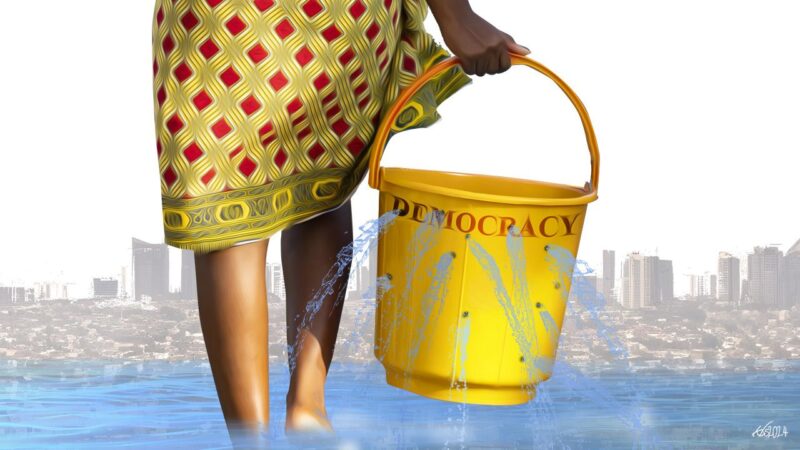“Build Back Better” is Developmentspeak for a particular approach to disaster recovery. The Global Facility for Disaster Reduction and Recovery defines it as “an approach to post-disaster recovery that reduces vulnerability to future disasters and builds community resilience to address physical, social, environmental, and economic vulnerabilities and shocks.” It looks forward to the post-COVID era and the potential to rebuild health, education and other human development systems in a fairer, greener and more robust way to minimise the likelihood and impact of future disasters.
The leaders of the USA and the UK use it frequently, Joe Biden more often than Boris Johnson. Unicef, which has mopped up Africa’s vaccine loans, has also adopted the phrase and has used it to signal better vaccine supply systems in the future. But BBB has been ridiculed in British social media and some Americans are irked by Biden’s “my Build Back Better Agenda” refrain repeated with every new policy announcement. African leaders have not yet adopted the mantra and there is hardly a trace of BBB on African social media.
At first, it sounded like more of the “revival of Empire” talk that accompanied the Brexit saga. A year into COVID, it is clear that what is being built back is the previous relationship between the developed world and developing countries before it was levelled out by the pandemic—for a brief moment in history, everyone was equally vulnerable. That moment has passed as recovery in developed countries outpaces recovery in Africa. Despite the far fewer deaths in Africa, the continent was more vulnerable to the economic shock caused by the pandemic. Recovery therefore requires more of that which was lacking in economic development prior to the onset of COVID: strong, accountable governance able to make and implement hard decisions.
According to the recently deceased Dr Anthony Mbonye, Uganda began to fail the governance test right at the beginning. The National COVID Task Force set up after the detection of Patient 0 in March 2020 excluded eleven doctors with experience of managing Ebola Virus Disease (of which Uganda has had five outbreaks), Yellow Fever and Cholera, in favour of some chosen on grounds irrelevant to the problem. This may explain why decision-making came to be dominated by the local World Health Organisation representative. Where a Ugandan may have understood the implications of contagion in Uganda, especially along truck routes through the poorest-served regions, the WHO representative was instrumental in lobbying to keep the borders open to truck drivers before their test results were known. During his mission, the representative was accompanied on media platforms by the permanent secretary in the Ministry of Health. In his book Dr Mbonye singles out the permanent secretary as part of the problem plaguing Uganda’s health sector. Since then, the rehabilitation of regional hospitals has failed to respond robustly to the Second Wave.
Whatever the development goals, recovery from the pandemic will require money, which is in short supply, with nearly all countries maxed out. Uganda’s public debt increased from 32 per cent to 37.5 per cent of GDP (an increase of ten percentage points since 2015). The current account deficit rose from US$1,999 million to US$3,205 million between 2018 and 2019. Debt repayments increased by US$17 million in the same period. The current account deficit that grew by US$740 million was plugged with funds from the World Bank’s Uganda COVID Response and Emergency Preparedness Project (UCREPP) and the US$300 million IMF Rapid Credit Facility in 2019/2020.
In order to put together a COVID Response, Uganda and many other African countries resorted to massive borrowing through the pro forma Emergency Response, Rapid Credit Relief and Economic Recovery programmes designed by the World Bank. Within weeks of Patient 0’s detection, the country was close to a billion dollars in COVID debt (bi-lateral debt not included). Under UCREPP, US$300 million was released by the World Bank for among other things, medical supplies, tax relief for businesses in key economic sectors like tourism and industry and to provide relief for the vulnerable. The IMF formed a joint framework with the Bank and added a credit facility of US$491 million. The African Development Bank chipped in with US$31 million to support the medical response, social protection and maintenance of macroeconomic stability and economic activity. The following year the IMF added another US$700 million while the World Bank has continued to lend under existing programmes.
On the face of it, there are elements of better development solutions within the COVID response. For example, in order to bypass the global shortage of protective gear, funds were made available to build local manufacturing capacity for face shields and masks. The simplicity of it was astounding. Where these items have been imported since Independence in 1962, a solution was found and implemented within weeks.
The main candidate for the Build Back Better approach is the health sector. Prior to the emergency, there were active health sector loans of a combined US$468,360,000 and a history of loan-funded interventions dating back at least twenty years. Still, the stock and quality of health infrastructure was in need of improvement, human resources needed to be enhanced and service delivery to be made more efficient and effective. Every major disbursement related to the COVID Response has been accompanied by a public outcry about irregular procurement methods and the incompetence that led to ICU beds remaining uninstalled for months after delivery. The climax came when over 30 patients died in one day and it was discovered that the new oxygen plant acquired by the national referral hospital was not fit for purpose. The seven USh7 billion (US$1,883,587) contract had been handed over to the daughter-in-law of ruler Yoweri Museveni and her twin sister, a newly elected member of parliament. They are the daughters of disgraced former minister of foreign affairs Sam Kutesa.
A budget of USh32 billion (US$8,996,240) to procure cloth masks from local manufacturers quickly ballooned to over USh70 billion. Awards of contract followed the usual pattern—the government paid a price four times the production cost, contracts were awarded to people within the President’s Office and to a firm in the entertainment industry and to other entities not connected to garment manufacturing. To produce the masks would therefore entail sub-contracting, with the attendant price inflation. Whole districts did not receive any cloth masks.
Every major disbursement related to the COVID Response has been accompanied by a public outcry about irregular procurement methods.
A challenge that has existed since 1995—when I first encountered it—is the storage and distribution of essential drugs and medical supplies. Over the years, massive amounts of expired drugs have either been destroyed or remain in stores. At the same time, stock-outs of essential drugs are a widespread annual occurrence across health facilities. Symptoms have persisted throughout the pandemic. Some quarantine centres were shut down after being in existence for some time without the means to manage patients. Hospitals have lost patients for lack of oxygen. Health workers have been on strike over Personal Protective Equipment (PPE). Rivalling Mulago Hospital’s oxygen debacle for incompetence, the medical stores lost an entire donation of half-a-million face masks. COVID test kits and drugs were later discovered being off-loaded from a truck onto private vehicles by a side-road.
The IMF is on track for BBB having reignited a lending relationship with Uganda that has been dormant since 2006. The World Bank has consolidated its dominance especially through its Hands-on Enhanced Implementation Support mechanism or Bank Facilitated Procurement through which it has supported the suppliers of its choice, and captured the African pharmaceuticals market. In this way, any possibility of Uganda cooperating with countries outside Europe and North America on vaccine acquisition and technology transfer has been extinguished. As a result, European and North American vaccine-supplying countries will also Build Back Better, financed by COVID outflows from countries like Uganda.
The easy borrowing under UCREPP was made possible by simply reopening or extending existing projects that were closed or closing in 2020/21: Uganda Health Systems Strengthening Project, East African Public Health Laboratory Networking Project, Agriculture Cluster Development Project (ending in 2021), and the Uganda Multi-Sectoral Food Security Nutrition Project.
New loans unrelated to the pandemic were sought and granted: Roads and Bridges in the Refugee Hosting Districts/Koboko-Yumbe-Moyo Road Corridor Project (US$130m); Uganda Intergovernmental Fiscal Transfers (US$300 million additional financing); Securing Uganda’s Natural Resource Base in Protected Areas Project (US$2.7 million); and the Uganda Digital Acceleration Project—GovNet (US$200 million).
The IMF is on track for BBB having reignited a lending relationship with Uganda that has been dormant since 2006.
In the meantime, repayments of multi-lateral loans continue uninterrupted. For example, since the pandemic was detected in Uganda in March 2020, an amount of US$8,222,820.93 has been repaid to the World Bank on the 2006 Transport Sector Development Project and US$988,160.75 on the 2011 East African Public Health Laboratory Project.
Appointed by the World Bank’s Assisted Procurement, Unicef has done better than Uganda’s entire COVID Task Force and members of the cabinet. It has carried out its biggest procurement assignment yet under the most stringent conditions. Individuals within Unicef and WHO have added key contacts to their address books, and pandemic management to their skillsets.
By surrendering their responsibility, Ugandan government representatives are now unable to say on any given platform what brand of vaccine would serve the country best, or why and when it is arriving. Tragically, while Iran and Vietnam have tested Cuban vaccines and are building for future pandemics by reaching technology transfer agreements with Cuba’s Finlay Institute of Public Health to create domestic production capacity, Uganda has not taken delivery of a single paid-for phial of vaccine. All the doses received a year and four months since COVID-19 made landfall have been donations.








